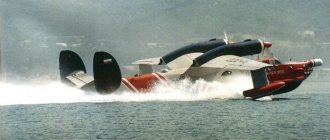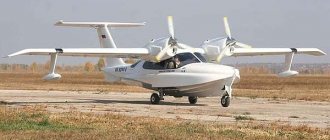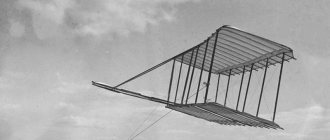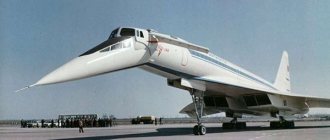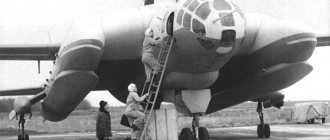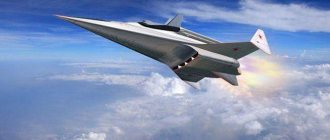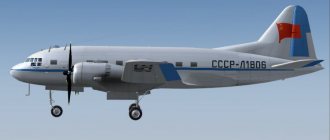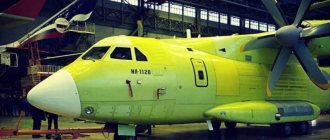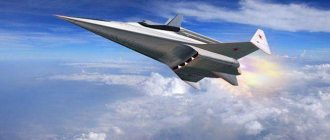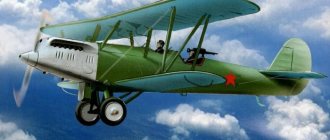THE BIRTH OF A LEGEND
Work on the new Be-12 turboprop amphibian to replace the Be-6 flying boat began at the G.M. Design Bureau. Beriev in 1956. Unlike its predecessor, it was supposed to be a search and strike vehicle equipped with a radar, search and sighting system, magnetometer, as well as radio sonobuoys (RSB), depth charges (GB) and anti-submarine torpedoes. At the same time, the designers were required to reconsider the very philosophy of designing the new machine, since before this the main attention was paid to the flight performance characteristics of the aircraft, and the means of combating submarines were considered secondary. Now it was necessary to create a unified aviation anti-submarine complex that would provide both search and destruction of enemy submarines.
In its design, the Be-12 (product “E” according to the OKB’s internal designation) was close to the Be-6, but exceeded it in weight and size, becoming at that time the largest amphibious aircraft in the world. The flight range was supposed to reach 3300 km, the search time at the turn of 600 km from the take-off airfield was 3 hours.
The maximum mass of the combat load, the composition of which could vary depending on the task, was increased to 3 tons (GB, AT-1 (AT-1M) torpedoes, mines, RSL RSL-N "Iva", RSL-NM "Chinara" and RSL -1). In the search version, the aircraft carried 90 buoys, in the strike version - three AT-1 torpedoes, in the search and strike version - 24 RSL-NM and one torpedo.
The search and targeting system included the Baku radiohydroacoustic system, the APM-60E aviation search magnetometer, the Initiative-2B radar, the ANP-1V-1 automatic navigation device, and the PVU-S Siren-2 sighting and computing device.
Factory flight tests of the experimental Be-12 began on October 18, 1960. Test flights have shown that the aerohydrodynamic configuration of the aircraft, its stability and controllability meet the necessary requirements. Unfortunately, on November 24, 1961, during a test flight over the Sea of Azov, near Zhdanov (now Mariupol), the first Be-12 prototype crashed and sank.
The second experimental Be-12 aircraft was built by September 1962. Its design took into account and eliminated the shortcomings identified during testing of the first machine. The engines were raised away from the water, installing them above the wing, which was removed from the anti-flutter weights, giving the consoles greater rigidity. New, wider spray deflectors were placed in the nose. In agreement with the military, the deck-mounted cannon installation was finally abandoned and the composition of the on-board radio-electronic (avionics) and other equipment was expanded and updated.
On the first vehicle, the Initiative radar antenna was installed in the bottom of the boat in front of the first step. Before landing, it was pulled inward, and the hole was closed with a lid with complex drive kinematics. If this mechanism failed, landing on water became impossible. By decision of G.M. The Beriev antenna was moved to the nose and installed above the navigator's cabin. Starting from the second prototype, all Be-12s received a characteristic “duck” nose.
State tests of the second prototype passed without incident and were completed on April 20, 1965. With a flight weight of 35 tons, the Be-12 showed seaworthiness up to three points, a maximum speed of 550 km/h, reached a service ceiling of 12,100 m and a flight range of 4,000 km. On November 29, 1968, by order of the USSR Minister of Defense, the Be-12 anti-submarine amphibious aircraft was put into service.
IYULNKER ae-14OPEDMYUGMYUVEM DK ONHYAYU, YAOYUYAEMKH SHYHOYUFEI YAYULNKERNB, ONREPOEBHU YUBYUPHCH MYUD LNPEL, KH NYUGYUMH ONLNYH SHYHOYUFYUL YNPYUAKEI KH YSDNB, REPOYKHU AEDYARBKHE MU LNPE . nM ASHK ONYARPNEM B 1965 Ts. MU AYUGE YYULNKERYU aE-12. YANYARYUB SHYKHOYUFYU - LEYARE VEKNBEY: DBY KERVHYU, LRSPLYUM, PYUDHYAR, ANPRREUMKHY, LEDPUANRMKHY.
OPEDONKYUTSYUKNYAE, VRN SHCHYHOYUF YAYULNKERYU B GYUBHYAHLNYARH NR NAYARYUMNBYKH YALNFER NYUGSHBURE ONLNYE I BNGDSU HKKH I ONYYUDYNI B PYYINME AEDYARBKH. dK ONHYAYU NAZEYRNB YAOYUYAEMKH OPEDMYUGMYUVYUKYUYAE pkya “x-2a”, YANOPFEMMYU I PUDHNOPHELMSHL SYARPNIYARBNL LYUYINB-NRBERVKHYNB Pol-I, sib PUDHNNLOYUYANL yupy-s2 X DPSTSHLH YAPEDYARBYULH.
dK NYUGYUMH ONLNYH I BNGDSUYU OPEDONKYUTSYUKNYAE YAAPYUYASHBURE YAOYUYUREKEMSHE YAPEDYARBU B BNYAELH YNMREIMEPYU yuya-90, ONDBEKHBUELSHU MU AYUKNVMSHU DEPFYUREKU OND YP SHKNL.
oPH OPNBEDEMHH YAOYUYUREKEMSHU NOYUPYUZHHI I ONYUDYNI MU BNDS YAYULNKER ASHK YAONYANAYEM DAYYUBHRE 10 YAOYUYUREKEMSHU OKNRNB oyam-6yu YAN YAMYUPFEMHEL. I HYAONKEGNBYUMHEL YAOYUYUREKEMNI KNDYKH kyuya-5ya, TYUKYU I ONOKYUBYULH, LEUUMHVEYAYNTSN RPYUOYU, SYARYUMYUBKHBUELNTSN MU KEBNL ANPRS B YAEDELNL NRYAYE HLEKYUYAE BNGLNFMNYARE ONDM YRE MU ANPR ONYARPYUDYUBKHU KH PUGLEYARKHRE KHU MU ONKYUU, MNYAHKYUU, DHBYUMYUU (MNPLYUKEMSHI BYUPKHYUMR - 15TH CENTURY, LYUYAHLYUKEMSHI - 29TH CENTURY. ) B RPEU YAOEZHYUKEMN NANPSDNBYUMMSHU BEMRHKHPSELSHU X NANTSPEBUELSHU NRYAYUU KNDYKH.
dK NYUGYUMH OEPBNI ONLNYH ONYARPYUDYUBHL B NRYAYYUU OPEDSYALYURPHBYUKKHYAE MENAUNDHLSHE KHMYARPSLEMRSH, YUBYUPKHIMSHI OKHYEBNI GYUOYUYA, AYU-REPLNYA, LEDKHZHHMYAYKHE HMSH, YAREP HKHGYURNP.
MU YAKSVUI BSHMSFDEMMNI ONYYUDYKH YYULNKERYU MU BNDS I ONYARPYUDYUBHLH MU ANPRS OPEDSYALYURPHBYUKHYAE YAOYUYUREKEMSHE OKNRSH oyam-6yu H oyam-10, Yu RUYFE KHMDHBHDSYUKEMSHE YAOYUYUREK EMSE YAPEDYARBU.
YaYULNKER-YULTHAKH aE-14 SYAOEMN GYUBEPHK HYAOSHRYUMHK, MN B YAEPKHCH ME ONYEK HG-GYU NTSPYUMHVEMMSHU THMYUMYANBSHU BNGLNFMNYAREI GYUYUGVHYU.
cru:
| lNDHTHYUZHH | aE-14 |
| pYUGLUU YPSHKYU, L | 29.84 |
| dKKHMYU YAYULNKERYU,L | 30.11 |
| bSHYANRYU YAYULNKERYU,L | 7.94 |
| OKNYYUDE YPSHKYU, L2 | 99.00 |
| I love it, JC | |
| OSYARNTSN YYULNKERYU | 24000 |
| MNPLYUKEMYU BGKERMYU | 29000 |
| LYUYAHLYUKEMYU BGKERMYU | 35500 |
| RNOKHBU | 9000 |
| RHO DBKHTSUREK | 2 rbd opntspeyaya yukh-20d |
| lnymnyare, Shch.K.Ya. | 2 U 5180 |
| LYUYAKHLYUKEMYU YAYNPNYARE, YL/V | 540 |
| yPEIYEPYAYU YAYNPNYARE, YL/V | 465 |
| oPUYRHVEYAYU DUKEMNYARE, YL | 3300 |
| aNEBNI PYUDKHSYA DEIYARBKH, YL | 650 |
| oPUYIRKHVEYAYKHI ONRNNKNY, L | 8000 |
| ShYKHOYUF, VEK | 6 |
| ONKEGMYU MYUTSPSGYU: | B MNPLYUKEMNL BYUPHYUMRE - 15, OPH OEPETSPSGYE - 29 VEKNBEY. |
| bottom. KhMTNPLYUZHKH: |
| VEPREF "aEPHEB aE-12 vYUIYU" tNRNTsPYUTKHH: | aE-14 |
| aE-14 | |
| aE-14 | |
| aE-14 | |
| aE-14 | |
| aE-14 | |
| aE-14 |
IWELSH:
| aE-14 |
| YNLONMNBNVMYU YAUELYU |
bYUPHYUMRSH NYPYYAYH:
| aE-14 (c) b. gNKNRNB |
| YaOHYANY HYARNVMKHYNB: |
| shYYAOPKHMR. Yu. gyuaknryaihi, yu. IYUKEMHYNB. YaYULNKER-YULTHAKH aE-12 yuMYURNKHI yuPRELEEB. aE-12: YAYULNKER RPEU YARKHUKHI yuKEYAYUMDP gYuAKNRYAYKHI, yMDPEI yaYUKEMKHYNB. 75 KER rumry HL. ts.l. aEPHEBU yuBKHYUZHKH bPEL 1997-03. b.m.lYUPRSHMEMYN, y.h.yaYUKEMKHYNB. “vYuYU” HG rYUTSYUMPNTSYu yBKHYUZHKH bPEL 1997-03. yuMYURNKHI yuPRELEEB. "vYuYU" MYUD LNPEL yPSHKE pNDHMSH 1996-09. mKHYNKYUYYSANBHV. "vYUIH" MYUD LNPEL lHP yuBHYUZHHH 2007-01. YaEPTSEY fBUMYAYKHI. KhYARNPHVEYAYKHI OSRE 49-I nokyush yuBKHYUZHKH YNYALNMYUBRKHYU 1996-07. YULTHAKH "aE" YUBHYYINKKEYZHKH 2012-03. Yu. gyuaknryaihi, yu. IYUKEMHYNB. YaYULNKER-YULTKHAKH aE-12 mKHYNKYUI YYSANBHV. bYAE YAYULNKERSH ts.l.aEPHEBU hyARNPKH YNMYARPSYZHHI YAYULNKERNB B yayap 1951-1965 Le Fana de l'Aviation 1978-03. Nico Sgarlato. Beriev Be-12 "Tchaika" Air International 1995-08. John Hayles. Russian's Coastal Guardian: The Beriev Be-12 Mail L+K 1971-23. Vaclav Nemecek. Berjev Be-12 Cajka |
sTSNKNY MEAYU. 2020
MODIFICATIONS, MODIFICATIONS
Initially at OKB G.M. Beriev envisaged the creation of a specialized aircraft based on the Be-12 for conducting search and rescue operations on the high seas. It was intended to search for crews of aircraft and ships that had crashed on the high seas both day and night in normal and adverse weather conditions. In 1965, the aircraft was built and received the designation Be-14. Almost all the internal compartments of the fuselage of this vehicle were adapted to accommodate people in distress and provide them with first aid. The plane was capable of receiving and evacuating up to 15 people, and in the overload version - up to 29, for which there were rescue hatches on the sides of the boat. The vehicle was equipped with additional disposable inflatable rafts, lifebuoys, ropes with floats, a supply of medicines and other rescue and medical equipment. All this required a thorough rearrangement of the seaplane boat.
Instead of a cargo compartment, places were equipped to accommodate the rescued, while the bottom and deck hatches of the compartment were eliminated. The radio operator's workplace and his blister were moved forward several frames, and the APU was moved back. The container with the inflatable rescue boat was moved from the starboard side to the deck. Hatches for receiving people from the water were now located on both the starboard and port sides. The avionics included the RPM-S transponder beacon radio receiver coupled with the on-board radar, the ARK-U2 VHF radio compass and the RSIU-5V VHF radio station. The crew has increased by two people – a flight doctor and a flight technician. For better working conditions for the crew at night when landing in a disaster area, the cockpits were illuminated with red light on the consoles and instrument dials, and a retractable spotlight was installed to search for victims afloat.
The Be-14 successfully passed tests, but was not put into serial production due to the insufficient financial capabilities of the customer. The only vehicle built was used for some time in the 49th separate anti-submarine squadron (oplae) of the Baltic Fleet aviation.
However, the military could not completely abandon search and rescue aircraft, so at their request, the OKB developed a rescue aircraft based on the serial Be-12 with more modest capabilities than the Be-14. The first, in 1972, to convert the serial Be-12 into a search and rescue version of the Be-12PS (aka “product “3E”). Weapons and special equipment were removed from it, instead of which were placed rescue and medical equipment, a small inflatable boat with a motor, a special mechanized ladder for receiving victims through a hatch in the starboard side of the boat and other life-saving equipment for picking up victims from the water and providing them with first aid. The Be-12PS could carry up to 13 people, and up to eight KAS-90 discardable emergency containers could be hung on the aircraft.
The Be-12 was built serially at the Taganrog Aviation Plant No. 86 named after. Georgiy Dimitrov from 1963 to 1973, in total - together with experienced ones - 143 vehicles were manufactured in anti-submarine and search and rescue modifications. One of the production Be-12s was converted into a record-breaking aircraft. The amphibian, declared in FAI documents as the M-12, set 42 world records.
The equipment and weapons of the Be-12 were constantly improved. Since 1973, RSL-NM1 “Zheton” buoys began to come into service, capable of receiving low-frequency noise that travels better in water. This increased the detection range of submarines.
The Be-12SK variant (product "ESK") was intended to use the SK-1 "Skalp" nuclear depth charge. On the Be-12SK, which had a thermally stabilized cargo compartment, it was possible to hang one such bomb and up to 10 RGBs on external holders to clarify the contact obtained. The cargo compartment was heated by two electric heaters. There were also nodes for attaching a protective tent used on the ground to retain heat in the cargo compartment when the doors are open. In the cockpits of the navigator and pilots, there were release control panels, air temperature indicators in the cargo compartment, as well as a special locking device to prevent unauthorized use of ammunition. The aircraft was tested in 1963–1964 as a carrier of anti-submarine nuclear weapons without being involved in full-scale nuclear tests at the Bagerovo Air Force test site in Crimea.
In April 1976, a modified version of the Be-12N (product “EN”) was put into service, on which an improved search and targeting system was installed. It included: an AMP-73S aircraft magnetometer, a modified Initiative-2BN radar, a Nara multi-channel unified receiving device, an on-board SPARU-55 receiving device, a Narcissus sighting and computing device with a target analyzer, as well as PC telecode equipment -025. In addition to the RSL-NM and RSL-NM-1 buoys, ten passive directional buoys of the RSL-2 Berkut system began to be suspended on the aircraft, which ensured the measurement of bearings on the submarine relative to the buoy. Production vehicles were upgraded to this option when undergoing major overhauls. A total of 27 aircraft were converted to the Be-12N variant.
In 1981, four aircraft in the anti-submarine version were delivered to Vietnam. At the same time, the airframe, engines and equipment were modified for operation in tropical conditions. The planes were delivered from Odessa to Cam Ranh by sea.
"WORKHORSE" OF ANTI-SUBARINE AIRCRAFT
The first two Be-12s arrived at the 33rd Naval Aviation Training Center in Nikolaev in the spring of 1965, where the retraining of flight personnel for the new aircraft began. By the end of 1970, three air regiments and two naval aviation squadrons had switched to the new aircraft.
The main task of the Be-12 was to perform combat service as part of their fleets. The tasks of combat service were solved in two main forms. The crews could be at the airfield in a high degree of readiness for departure to conduct a “search on call” or conduct the search independently or together with heterogeneous fleet forces.
In the early years, the search for submarines was carried out mainly using a radar or magnetometer, since there were not enough rather expensive RSLs. Depending on the theater, there were subtleties in using a magnetometer. If at the great depths of the Pacific Ocean or the Barents Sea the magnetometer was a fairly useful tool, then in the shallow Baltic, littered with various iron during two world wars, the device worked often, but to no avail. In addition, the main object of the search in the Baltic Sea were West German submarines of projects 205 and 206, which had a small displacement and hulls made of low-magnetic steel. The Germans were so skillful at demagnetizing their submarines that magnetometers often ignored them altogether. Therefore, the crews of the 49th Airborne Fleet relied more on radar, buoys, or their own eyes in their search.
The Pacific crews of the Be-12 achieved the first detections of submarines in the Sea of Japan in 1968, visually in the Baltic in 1973, and visually in the Northern Fleet immediately after the aircraft arrived at the fleet in 1968. As experience was gained, the scale of work increased. One of the operations took place on August 18–23, 1974 in the Barents Sea. It began with setting up RSL fields in a given area. One of the crews managed to establish contact with the unidentified submarine and transfer it to the ship's search and strike group, which immediately lost it. The pilots, having put up an intercepting barrier of buoys, restored contact and tried twice more to transfer it to surface ships, but to no avail. Later, Il-38 and Tu-142 arrived in the area. As a result, the longest tracking in the history of anti-submarine aviation lasted 59 hours and 15 minutes, of which 58 hours by planes and helicopters.
Initially, Be-12 crews carried out search operations at a distance of 200–300 km from their coast. But the political conflicts of the Cold War led to the fact that in March 1968 an agreement was signed between the USSR and the Arab Republic of Egypt on the temporary basing on its territory of a group of six Tu-16R reconnaissance aircraft to conduct reconnaissance in the Mediterranean Sea in the interests of both countries. This group was named the 90th separate long-range reconnaissance squadron for special purposes. Soon the Tu-16R was joined by two An-12RR radio reconnaissance aircraft, and on August 19, 1968, three Be-12s from the Black Sea 318th separate anti-submarine air regiment (oplap).
Cars with Egyptian markings were transported to the Cairo West airfield from the Soviet Union through Hungary and Yugoslavia. The arriving crews began flying at their new base a week later, although due to the unusual heat they tried to fly mainly in the morning hours. The maximum distance between the search areas and the home airfield did not exceed 350–400 km. Subsequently, due to the fact that the Cairo West airfield was located at a distance of over 200 km from the coast, by agreement with the Egyptian side, the Be-12 was relocated closer to the sea, to Mersa Matruh.
Two months later, after conducting a series of exercises, the Be-12, together with the anti-submarine cruiser Moskva and the large anti-submarine ships Reshetelny and Brave, took part in the first search operation. As a result, in October 1968, two foreign submarines were discovered for the first time in the Mediterranean Sea. The first one was tracked for 1 hour 37 minutes, the second one – 48 minutes. In June 1971, Be-12s in Egypt were replaced by Il-38 aircraft.
The total flight time of Navy aviation in combat service to search for submarines from 1965 to 1981 amounted to 81,124 hours, of which 37,205 hours fell on the Be-12. The peak of activity in the use of the Be-12 in combat service was 1989–1990, and in 1989, Be-12 crews discovered 29 foreign submarines.
By 1991, the Be-12 amphibians of the USSR Navy aviation were operated in the 555th Instructor and Research Anti-Submarine Aviation Regiment and the 316th Operations Squadron of the 33rd Combat Use Center (Ochakov and Kulbakino airfields), in the 403rd Operational Operations Division of the Northern Fleet Aviation (Severomorsk-2 airfield ), in the 318th aviation detachment of the Black Sea Fleet (Donuzlav airfield in Crimea), in the 49th aviation detachment of the Baltic Fleet (Kosa airfield near Baltiysk), in the 289th separate anti-submarine and 317th separate mixed air regiments of the Pacific Fleet aviation (Nikolaevka airfields in Primorye and Yelizovo near Petropavlovsk-Kamchatsky).
In addition to the naval aviation, amphibians were also operated by the Air Force from 1971 to 1983 - in the 163rd training aviation regiment, and then as part of a squadron - in the 130th training regiment of the Voroshilovgrad Higher Military Aviation School of Navigators. They trained cadet navigators in anti-submarine warfare.
AT THE TURN OF THE MILLENNIUM
In 1992, the Be-12 was officially withdrawn from service, although the vehicles continued to be used in units until their service life was exhausted. By the beginning of the 21st century, the anti-submarine Be-12 and search and rescue Be-12PS remained only in the combat formation of the Russian Black Sea Fleet and the Ukrainian Navy.
Russian Be-12s are part of an anti-submarine squadron as part of a separate mixed air regiment of the Black Sea Fleet Naval Aviation at the Crimean Kacha airfield. This longevity of the Kachin amphibians is explained by the fact that, within the framework of the documents signed at one time with Ukraine on the basing of the Russian Black Sea Fleet in Crimea, our country was limited in its ability to renew the fleet of naval aviation aircraft of the Black Sea Fleet.
During the division of the Soviet Black Sea Fleet, 11 Be-12s passed to Russia, but not all of them are in flying condition today. In addition, in recent years, Be-12s have been operated only from land airfields: the last time they flew from water was in the summer of 2006.
Ukraine received a total of 15 Be-12s of various modifications from the USSR Armed Forces. Since 2004, the only air base of Ukrainian naval aviation has been the Novofedorivka (Saki) airfield in Crimea, where Ukrainian Be-12s, which became part of the 10th naval aviation brigade of the Ukrainian Navy, began to be based. Like Russian vehicles, Ukrainian amphibians have not flown from water in recent years. They underwent maintenance and certain types of repairs in Crimea at the Evpatoria Aircraft Repair Plant.
Over the years of independence, the number of Ukrainian Navy Be-12s in service has decreased radically. In 2012, the 10th Naval Aviation Brigade had only four flightable Be-12s (of which two search and rescue Be-12PS), three more vehicles were in storage. But, apparently, the Ukrainian Navy was unable to maintain even such a number of Be-12s in flying condition, therefore, when the events of the “Crimean Spring” began, only two out of four Be-12s were able to take off. These two vehicles (Be-12PS and Be-12) were transported on March 3 and April 14, 2014 from Crimea to the Kulbakino airfield (Nikolaev), where they remain to this day. Considering the general trends in Ukrainian military development, as well as the lack of a repair base, most likely both amphibians will eventually be scrapped.
As for the Russian Be-12, despite the fact that their search and sighting system has long been outdated, in the hands of a trained crew it is still quite an effective tool, as was clearly shown by the anti-submarine aviation crew competitions that took place in 2014 in the Northern Fleet. Anti-submarine pilots of the naval aviation of the Northern, Pacific and Black Sea fleets competed in performing tactical techniques for searching, classifying and tracking submarines using radar and hydroacoustic anti-submarine detection equipment. The Chernomorians took part in the competition on their regular Be-12s and performed quite well.
Nevertheless, the technical condition of the aircraft, which were in operation for more than 20 years without major repairs (only work was carried out to extend their service life), caused serious problems. In 2010, the option of replacing the Black Sea Be-12s with Il-38s was even considered, but the implementation of this plan was prevented by the uncompromising position of the Ukrainian side.
As a result, in 2012 it was decided to conduct it at TANTK named after. G.M. Beriev overhaul of the Be-12, including engine repair and replacement of propellers. During 2012–2013, four Be-12s were transported from Kachi to Taganrog. Some problems associated with the loss of a number of technologies and the cessation of production of individual units and components were overcome, and in 2014–2015, four repaired aircraft were handed over to Black Sea aviators.
Since the last time the Be-12 search equipment was updated was more than 35 years ago, the next step should be the modernization of the aircraft’s obsolete search and sighting system. In particular, at the beginning of this year, information appeared in the media that the High Command of the Navy had made a fundamental decision to modernize the amphibious avionics. It is planned that in order to increase the search potential and combat effectiveness of the aircraft, the search equipment on it will be radically updated and the Be-12 will be able to use new modern drop-drop means for searching and destroying submarines.
Decline of the era of hydroaviation
Taganrog Aviation Scientific and Technical Complex (TANTK) named after. Beriev is the only large design bureau in the world specializing in the creation of amphibious aircraft. Meanwhile, world practice shows that the development of hydroaviation today is an unpromising, obviously unprofitable activity and is possible only with the direct support of the state. From an economic point of view, it is more expedient to reorient TANTK and its serial production to the development and construction of “land” (not amphibious) special aircraft. This process of reorientation began in the USSR, but was suspended in the post-Soviet period.
Origins of naval aircraft construction
Taganrog Aviation Scientific and Technical Complex named after. Beriev's history dates back to 1934, when the Central Design Bureau (TsKB) for naval aircraft construction was formed in Taganrog at aircraft plant No. 31. The first task was to organize the production of a naval short-range reconnaissance aircraft - the MBR-2 flying boat, developed in 1932 by G. M. Beriev (1903–1979). As a result, Beriev was appointed chief designer of this Central Design Bureau. Before that, he worked as the head of brigade No. 5 (naval aircraft) of the Central Design Bureau at aircraft plant No. 39. This bureau was organized in 1933 and was headed by S. V. Ilyushin.
MBR-2
After the war, under the leadership of Beriev, a new multi-purpose flying boat, the Be-6, was developed for the USSR Navy, which made its first flight in 1948 and was produced at Plant No. 86 in 1952–1957 (123 aircraft). However, the main focus of the OKB was the creation of a seaplane with a jet engine. In 1952, an experimental jet flying boat R-1 was created, and by the end of the 50s it was possible to develop the world's first serial jet seaplane, called the Be-10. In 1958–1961, Plant No. 86 built 27 of these flying boats in the torpedo bomber version. The Be-10 set 12 world records.
Be-6
Be-10
In 1967, pilot plant No. 49 was renamed the Taganrog Machine-Building Plant (TMZ), and serial plant No. 86 was renamed the Taganrog Mechanical Plant named after. Dmitrova. In 1968, Beriev retired and A.K. Konstantinov was appointed the new chief designer of TMZ.
In October 1989, TMZ received the name Taganrog Scientific and Technical Complex (TANTK), and in December of the same year the plant was named after its founder, G. M. Beriev. In turn, Taganrog Mechanical Plant named after. Dmitrov was renamed the Taganrog Aviation Production Enterprise named after. Dmitrova.
“The only real product of TANTK in its area of specialization remains the Be-200. However, there are not a large number of people willing to buy it.”
In the 70s, funding for R&D on hydroaviation in the USSR was greatly reduced. At that time, the Taganrog Machine-Building Plant was conducting R&D on deck- and land-based anti-submarine aircraft. In 1977, with the assistance of TMZ, they created the Tu-142MR repeater aircraft, and in 1978, the A-50 long-range radar detection and control aircraft (based on the Il-76). Moreover, in the latter case, TMZ acted as the main contractor and integrator of the project (Il-76 aircraft were built in Tashkent, the developer of the main radio complex for them with the Shmel radar was NPO Vega). Just in the 80s at the Taganrog Mechanical Plant named after. Dmitrov produced 25 A-50s. In Soviet times, TMZ also began work on an aviation combat laser complex under the code A-60 (two experimental aircraft based on the Il-76 were manufactured).
However, the amphibious theme was not completely curtailed. In 1973, in the interests of the USSR Navy, development began on a new anti-submarine seaplane with jet engines to replace the Be-12. In 1986, the vehicle, designated A-40 Albatross, made its first flight. With a maximum take-off weight of 90 tons, this aircraft became the largest amphibious jet aircraft in the world. In 1995, due to the cessation of government funding, testing of the A-40 was suspended; by that time, only two prototypes had been built. It was decided to resume the program in a revised form and under the designation A-42 only in 2007.
B-12
In parallel with the development of the A-40, TMZ was creating a similar in concept, but more compact multi-purpose amphibious aircraft A-200 with a take-off weight of 40 tons. Its production was planned to be organized at the Irkutsk Aviation Production Association (IAPO). In 1990, a preliminary design was ready, but the first flight of the prototype took place only in 1998. The aircraft was renamed the Be-200 and in the post-Soviet period it became the basis of cooperation between the Taganrog enterprise and the Irkut corporation, created after the collapse of the USSR on the basis of IAPO.
A-40
In 2006, the state-owned United Aircraft Corporation (UAC) was established, uniting all the key enterprises in the industry, including NPK Irkut and OJSC Tupolev. As a result, TANTK named after. Beriev and Tavia (OJSC Taganrog Aviation) found themselves under full state control, although in relation to TANTK the formal structure of shareholders remained the same.
After the creation of the UAC, Alexey Fedorov, who became the head of the corporation, realized his previous intention and lobbied for the decision to move the production of the Be-200 from Irkutsk to Taganrog. The relocation of production should be completed by 2013; it is planned to spend 4.8 billion rubles for these purposes.
Today TANTK named after. Beriev is part of the UAC special aviation division, which, in addition to hydroaviation, will be engaged in the creation of strategic and long-range Tupolev bombers and special aircraft based on the Tu-214 and Il-76. Based on priorities, JSC Tupolev was chosen as the base enterprise of the division. However, despite the secondary role in the TANTK division named after. Beriev, this design bureau, together with its serial design bureau, has been designated the UAC center of competence for hydroamphibious aviation.
TANTK and Tavia are headed by Viktor Kobzev, who previously held the position of head of Beta-IR CJSC, a joint venture of IAPO, TANTK and Tavia, created in 1990 to implement the Be-200 program (now a controlling stake in this joint venture belongs to Irkut ).
Main programs
Be-200
The first customer of the Be-200 was the Ministry of Emergency Situations of the Russian Federation. In accordance with the contract signed back in January 1997, the Ministry of Emergency Situations ordered seven aircraft in the Be-200ES variant (can be used as search and rescue, firefighting and transport), the first of which was built in 2003. However, in reality, by 2006 the ministry had received only four production aircraft (serial numbers 101, 102, 201 and 202) and then seemed to have lost interest in the Be-200. The fifth aircraft built for the Russian Ministry of Emergency Situations (serial number 203) was sold to the Ministry of Emergency Situations of Azerbaijan in April 2008. The construction of the remaining two aircraft was slowed down, and the sixth aircraft (serial number 301) made its first flight in Irkutsk only in July 2010. The seventh Be-200ChS (serial number 302) should be completed in 2011, while the head side 101 was taken out of service and sent in 2008 to TANTK for repairs, where it remains to this day.
The situation with the domestic order for the Be-200 changed due to a large number of forest fires in Russia in July-August last year due to the abnormally hot summer. As a result of the events, the Russian government decided to purchase eight more Be-200ES for the Ministry of Emergency Situations. Delivery of the first two aircraft from Irkut's stock is expected in 2011, the remaining six will be built by Tavia and delivered in two batches of three aircraft in 2012 and 2013. At the same time, the cost of the eight ordered vehicles is 12 billion rubles.
At the same time, the Russian side continues to market the Be-200 on the world market, promoting it mainly in the fire-fighting version, however, due to the high cost, the chances of concluding contracts are unlikely. Foreign countries prefer not to buy the Be-200 for end use, but to lease it to solve pressing problems. At various times, EMERCOM aircraft were used to extinguish fires in Italy (2004–2005), Portugal (2006–2007), Indonesia (2006), Greece (2007), Israel (2010). The only foreign buyer of the Be-200 so far is the Ministry of Emergency Situations of Azerbaijan, which received the above-mentioned aircraft 203 in 2008.
Be-200
Offers of the Be-200 aircraft in cargo, medical, administrative, passenger (Be-210), search and rescue (Be-200PS), anti-submarine (Be-200P), patrol (Be-200MP, Be-220) and others options also did not find customers.
In May 2010, the Indian Navy requested information (RfP) on the possibility of supplying six Be-200s. Delhi plans to use them as patrol and search and rescue missions, deploying them in the Andaman and Nicobar Islands. The tender will apparently also include Bombardier 415 and Dornier Seastar aircraft.
Aircraft based on the Be-200
For most modifications of the Be-200 (with the possible exception of the fire-fighting version), amphibiousness seems to be a dubious advantage, which only complicates the vehicle and worsens its aerodynamic and weight characteristics. Therefore, TANTK’s projects to create “land” variants based on the Be-200, replacing the “boat” fuselage with a conventional one (aircraft type), became quite logical. It is known that TANTK is currently working on two “land” versions of the Be-200 - the Be-250 AWACS and control aircraft (for a promising radar complex developed by the Vega concern) and the Be-300 aircraft in patrol and anti-submarine versions Be-300MP ( with the installation of the promising search and targeting system "Kasatka" developed by OJSC "Radar-MMS"). “Kasatka” is also offered for the new patrol version of the Be-200 amphibian under the designation Be-200MP.
A-50
In 1978, with the leading role of TANTK, the A-50 AWACS and control aircraft was created. The task of the Beriev Design Bureau included the integration of the complex and the adaptation of the Il-76 military transport aircraft to accommodate the Shmel radio-technical complex developed by NPO Vega. In 1978–1983, three A-50 prototypes (product A) were converted in Taganrog. Serial production of the A-50 was carried out in Tashkent with the installation of a radar complex in Taganrog from 1984 to 1990 (a total of 25 serial vehicles were built).
Since 1984, development of a modified A-50M aircraft with the Shmel-2 radar system and PS-90A-76 engines has been underway, but in 1990 work was stopped, and the prototype remained unfinished in Tashkent.
In 1997 (now Rosoboronexport) and the Israeli corporation IAI signed an agreement on the creation of the A-50I AWACS and control aircraft. The Israeli radar system IAI Phalcon with EL/M-2075 radar with phased array antennas was installed on the vehicle. The customer for the aircraft was China, which ordered four aircraft worth one billion dollars in 1997. By 2000, work on the first vehicle was completed by converting one of the former serial A-50s, but the United States demanded that Israel stop cooperation with China. In 2001, the Phalcon complex was dismantled from the converted A-50I, and the empty side was transferred to the People's Republic of China in 2002, where it subsequently served as a platform for the creation of its own KJ-2000 AWACS aircraft.
India became the first real owner of the Russian-Israeli aircraft. In 2003, a contract worth $1.1 billion was signed to supply Delhi with three A-50EIs with an IAI Phalcon radar system and PS-90A-76 engines. According to it, the first car was planned to be delivered in 2006, and the last in 2009, but the contract is being implemented with serious delays. The first aircraft was sent from TANTK to Israel for the installation of a radar complex in January 2008 and was transferred to the Indian Air Force in complete form only in May 2009. The Indians received the second in March 2010. The third aircraft was relocated from TANTK to Israel in October 2010 and is expected to be delivered to the customer in 2011. Delhi intends to exercise an option for three additional aircraft.
Meanwhile, the modernization of combat A-50s of the Russian Air Force began. TANTK them. Berieva and the Vega concern successfully developed a modification of the A-50U with a modernized radio engineering complex. At the end of 2009, an act was signed on the completion of state joint tests of this machine. In 2010, the modernization of the first of the combat A-50s of the Russian Air Force into the A-50U variant was completed and work began on another aircraft. In total, the Russian Air Force currently operates 12 A-50 aircraft.
In parallel, TANTK, together with the Vega concern, is creating the A-100 AWACS and control aircraft with a new generation radar system, designed to replace the A-50. The platform for the new vehicle should be the same Il-76TD, and in the future, the Il-476, which is being developed in Voronezh. In August 2010, the general director of the Vega concern, Vladimir Verba, said that “in three to four years we will receive the latest complex on the same carrier (Il-76).”
Be-103
In the early 90s, TANTK began designing a lightweight six-seat multi-purpose piston amphibious aircraft, the Be-103. The first flight of the new machine took place in 1997. In addition to Russia, the Be-103 was certified in the USA, China, Brazil and the European Union from 2003 to 2008. At KnAAPO im. Gagarin (part of the Sukhoi holding company) a serial production line was launched. It was believed that the Be-103 had good market prospects. However, in reality, from 1997 to 2005, only ten experimental and production aircraft were built for Russian customers, and three of them crashed. Three more cars were delivered in 2003 to the USA, since then they have been resold several times.
Great hopes were pinned on the promotion of the Be-103 to China. In 2003, an agreement was concluded to supply 20 Be-103s to China with an option for another 10 aircraft. The issue of organizing licensed production of the Be-103 in China (in Huzhou) was also considered, the volume of which was estimated at no less than 50 aircraft. However, the Be-103 also failed in the Chinese direction. Although in 2003–2007 KnAAPO built all 20 aircraft of the Chinese order and laid down 10 under the option, in reality only two aircraft were delivered to the PRC in the fall of 2010 to China Flying Dragon Airlines from Tianjin. The Chinese side seems to have refused to accept the remaining aircraft, and these 18 Be-103 remain mothballed at KnAAPO. With a cost of about one million dollars and an increased accident rate that has been revealed, the Be-103 aircraft is clearly uncompetitive. To date, the program has effectively been discontinued.
Ekranolety and other projects
TANTK considers one of the promising areas to be the creation of super-heavy amphibians - ground effect aircraft with a take-off weight of 2,500 tons. Similar studies began in the USSR in the 80s. Now TANTK, together with TsAGI, continues to develop this topic, which Kobzev once again announced during the Hydroaviation Show 2010. The advantages of ground effect vehicles should be their high efficiency and high payload capacity. The creators see their main purpose in transoceanic container transportation. The ground effect vehicles will not require any special infrastructure; they can be operated using the capabilities of existing seaports. The implementation of the project, according to Kobzev, will take from 15 to 20 years and more than 10 billion dollars. However, it is highly doubtful that such funds will be found, especially since the economic feasibility has yet to be proven.
At the same time, TANTK continues to advertise projects of a number of amphibious aircraft that have been going on since the 90s - the four-seat light piston Be-101 (take-off weight up to 1.5 tons), twin-engine turboprop Be-112 (11 tons) and Be-114 (22 tons) and the corporate amphibian Be-170. The possibility of bringing all these programs to practical implementation is unlikely.
Unpromising directions
TANTK them. Beriev remains the only significant aviation design bureau in the world specializing in the field of hydroaviation, promoting its “unique competence” in this area. Meanwhile, it is obvious that the era of hydroaviation is becoming a thing of the past. Large seaplanes are left with only a very narrow niche of firefighting and search and rescue vehicles, and the real need for seaplanes even in this niche is questionable. Light-engine hydroaviation retains a certain importance, but here the demand is satisfied by float-based versions of conventional “land” light-engine aircraft; fortunately, in operation it is possible to easily replace the wheeled chassis with a float-mounted one and vice versa. There is no urgent need for specialized light-engine amphibians, the flight characteristics of which are obviously worse than “land” aircraft, and such amphibians are now small-scale exotic products for enthusiasts.
In light of this, TANTK’s stubborn commitment to hydroaviation condemns this company to a marginal position and leads to waste of funds on obviously unrealizable projects. It seems that there is and will not be any market demand for the amphibious projects currently being developed by TANTK (Be-101, Be-112, Be-114, Be-170), not to mention the frankly fantastic projects of ground effect aircraft. Attempts to revive the A-40/42 aircraft also do not have obvious significant prospects, and the idea of organizing the construction of just a few copies of the heavy and expensive A-42 for the Russian Navy looks very dubious from an economic and operational point of view and will most likely be revised by government agencies after an objective analysis.
The only real product of TANTK in its area of specialization remains the Be-200. However, there is not a significant number of people willing to buy it, and even the pilot customer (the Russian Ministry of Emergency Situations) clearly did not show much interest in this aircraft before the summer fires of 2010. The real prospects for continued production of the Be-200 depend mainly on how long the state will continue such acts of charity towards the UAC and TANTK at the expense of taxpayers.
The futility of the seaplane specialization of the OKB im. Beriev was already obvious by the 70s, and the decision of the leadership of the Soviet aviation industry of that time to repurpose the bureau in the direction of work on “special land” aviation should be considered completely justified. The amphibious projects A-40, Be-200 and Be-103 did not bring any benefit to either TANTK or the state as a whole, becoming costly relapses that clearly showed the dead end of this topic. As a result, even now, as can be judged, TANTK receives its main income not from participation in the production of custom Be-200s, but from the implementation of the A-50EI, A-50U, A-60 programs, R&D for new AWACS aircraft and other special machines, work for aircraft of the Tu-142 family, etc. The Be-250 and Be-300 projects also look very attractive, and the latter can become virtually the only option for a promising basic patrol and anti-submarine aircraft both for the Russian Navy and for export.
TANTK them. Beriev can have a long-term future only if the UAC leadership brings to its logical conclusion the repurposing of the Taganrog complex, which began in Soviet times, to create special-purpose aviation systems (fully focusing it on this topic, including the transfer of specialized topics from other Russian design bureaus). Obviously, this will simultaneously require a more solid approach to the subject of TANTK’s promising work, including stopping the dispersal of resources on unrealistic hydroaviation projects.
